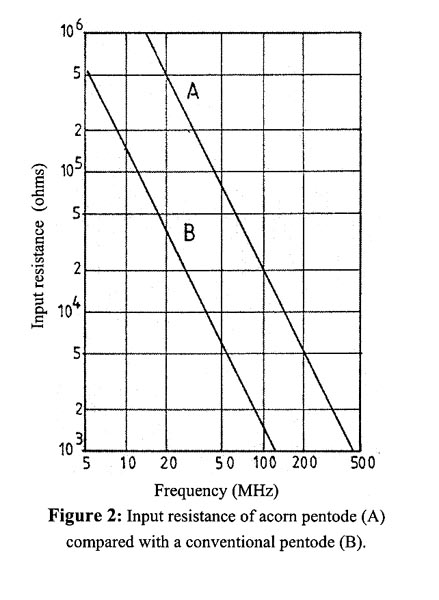|
A great deal of experimental research work was carried out at the RCA laboratories during the early 1930's to investigate the behaviour of radio frequency amplifier valves, where it was found that improved circuit performance could be achieved if the valve dimensions were reduced. With a linear reduction, the mutual conductance and other valve parameters remained almost unchanged, but the lead inductance, inter-electrode capacitance and electron transit time all fell in direct proportion to the reduction of dimensions. In fact, such a linear reduction was not practical; however, the tiny 'Acorn' valves that resulted from this work were capable of providing amplification at frequencies up to about 400 MHz.

The first of these valves to go into production was the type 955 triode which was introduced in 1934. This was followed by the 954 pentode in 1935 and a variable-mu pentode, the type 956, in 1936. They all had indirectly heated cathodes, operating at 6.3 V, 0.15 A. The diameter of the heater-cathode assembly was comparable with that of a common household pin and the overall length was less than one half. The capacitance between the control grid and the anode for both the triode and the pentode was about half that of conventional valves, and all other internal capacitances were also significantly reduced.
Before long, acorn valves, based on the RCA design, were introduced in Britain by Mazda, Marconi-Osram and Mullard. Initally, all the British acorn valves had 4 V heaters, but 6.3 V versions were introduced in 1940.

Figure two shows how the input resistance of a valve is affected by transit time, where a comparison is made between an acorn pentode and an equivalent, conventional pentode. At 30 MHz, the conventional pentode (B) has an input resistance of 17 k Ohms, which falls to only 1.5 k Ohms at 100 MHz. The equivalent figures for the acorn pentode (A) are 220 k Ohms at 30 MHz and 20 k Ohms at 100 MHz. This fall of input resistance, which has a critical effect on the amplification that the valve can provide is inversely proportional to the square of the frequency: if the frequency is doubled, the resistance falls by a factor of four and a ten-fold increase in frequency results in a hundred-fold decrease of input resistance. It is not difficult to see, therefore, that conventional valves were unsuitable for operation in the UHF band, whereas the acorn or similar miniature valves were better suited.
British companies, such as MOV and Mullard, found the acorn valves very difficult to manufacture because of the highly skilled labour required. As a result, considerable quantities of the valves were imported from the US for use in military radar equipment during World War 2. Because of the manufacturing problems and the eventual availability of alternative valves, the acorn valves were blacklisted by the Inter-Service Technical Valve Committee in June 1941.
The 95nn series acorn valves were used in receivers up to about 250 MHz. The diodes were also used as mixers in UHF receivers. When the later B7G based valves were intoduced the performance of the acorn valves was easily surpassed.
|